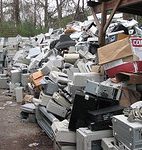A multitude of fire-retardant chemical producers and buyers thronged the Shanghai Expo Centre for the Third International New Flame-Retarding Technology and Flame-Retarding Material Industry Exhibition from September 15 to September 17, 2008. Although it is hard to believe that there were 3 million participants, as reported by the official exhibition website, the fire safety that was discussed is important and real. The sale of fire-retardant chemicals is highly profitable. In addition, the three western companies that produce these chemicals are the primary motivators behind these increasing sales in China.
Looking a little more closely at this exhibition, the scenario for an imminent environmental and human health disaster in both China and the whole world begins to unfold. However, it is a disaster that can be averted with education and prompt action.
Adding chemical fire retardants to couches, computers and children's toys may sound like a good idea. However, in lab animals, these chemicals can cause neurological and reproductive impairments; cancer; attention-deficit/hyperactivity disorder; infertility; reduced sperm count and endocrine disruption; cryptorchidism (undescended testicles); and hypospadias (a penile deformity), among other health disorders. And studies are underway to determine if fire-retardant chemicals are contributing to current increases in autism, hyperactivity, birth defects, infertility, diabetes and obesity in children.
The benefit of adding these chemicals to consumer products has not been proven to the satisfaction of those concerned about these health implications. Fire retardants can slow, but usually do not stop, fires. As materials treated with these chemicals smoulder for seconds or minutes, they instead create smoke, which is a leading cause of fire deaths. A decrease in smoking, more smoke detectors, sprinkler systems and better enforcement of fire safety standards are among the many – and more effective – ways to reduce fires and fire-related deaths. These do not pose the same potential danger to human health.
Consequently, many scientists, environmentalists, and even the International Association of Fire Fighters oppose the use of chemical flame-retardant additives, unless there is a proven need for their use, or if alternative methods of fire prevention are not adequate.
The most toxic fire retardants are halogenated chemicals, which contain chlorine or bromine bonded to carbon. They are often persistent and bioaccumulative. “Persistent” means that they do not break down into safer chemicals over time. For example, fire retardants, such as polychlorinated biphenyls (PCB) and polybrominated biphenyls (PBB) – banned more than three decades ago – are still present and problematic in sediments and wildlife. "Bioaccumulative" means that they accumulate in plants and animals, becoming more concentrated as they move up the food chain. Such chemicals are being detected at higher and higher levels in animals across the planet, from killer whales and polar bears to Tasmanian devils and housecats.
The use of halogenated chemicals is primarily promoted by the three major producers: Albermarle, Chemtura and Israeli Chemicals Ltd. As the European Union and the United States are using less of these chemicals, these three companies are turning to China for both manufacturing and sales. The Flame Retardant Expo is one of the tools these manufacturers use to increase their markets in China, and they appear to be succeeding.
The production capacity of flame retardants in China has gone from 50 kilotonnes in 1993 to 350 kilotonnes in 2006, and continues to grow rapidly. The market share for the more toxic halogenated fire-retardant chemicals is estimated to be 20% and declining in the European Union and the United States, while it is 55% and growing in China. In 1999, China produced 2.5 kilotonnes of the brominated fire retardants – the most toxic and persistent. However, by 2006, it produced 80 kilotonnes. This growth is expected to accelerate as Albermarle and Israeli Chemicals Ltd begin to manufacture halogenated fire retardants in China this year.
To increase the local market for their products, the companies are encouraging the government to set flammability requirements. A regulation for public places was promulgated in July 2008 by the Ministry of Public Security, just in time for the Olympics.
So far, the three companies producing bromine are the major voices for fire-retardant information in China. The Sichuan Fire Research Institute, which manages national fire protection standards, was forced to close following the Sichuan earthquake in May this year. For now, the institute is temporarily housed at Albemarle's Nanjing Technical Centre.
China needs to be informed about both the lack of proven benefit and the history of negative impacts of halogenated fire retardants on health and environment if they want to avoid the past mistakes of the United States.
These unfortunate mistakes began with the 1973 “Poisoning of Michigan”, a disaster that perhaps foreshadowed the recent tragedy of melamine (another fire retardant, which was added to milk and livestock feed). In 1973, one tonne of PBB fire retardant was inadvertently mixed with animal feed. The toxic flame retardants moved from farm animals to milk, eggs and meat, finally ending up in humans. Ultimately, millions of farm animals that had consumed the toxic mixture had to be culled, and humans with high levels of exposure had a 20 to 30-fold increased risk of some cancers.
The addition of the fire retardant pentabromodiphenyl ether (pentaBDE) to the polyurethane foam found in furniture and baby products in the United States is another vivid example of a case where the potential harm far exceeds the fire safety benefit. After pentaBDE was found to be highly toxic and persistent, it was banned in 2003 and the US manufacturer voluntarily ceased production in 2004. High levels of the chemical, primarily used to meet a California fire standard, are now found in creatures from all habitats, such as the polar peregrine falcons in the air, to sea otters on the ocean’s surface, to squid and octopuses one mile down.
Nursing babies are at the very top of the toxins food chain. Breast milk from Californian women contains fire retardants at levels approaching those that cause animal reproductive and neurological deficits in lab studies. Dust in Californian homes contains four to 10 times the pentaBDEs found in dust from other states and 200 times the amount in houses in Europe, according to a new study from the Silent Spring Institute. Worse, Californians have twice the level of this fire retardant in their blood as do people in other states. No other known toxins are found in homes at levels as high as these chemical fire retardants.
Were Californian families safer from fires because of the toxic chemicals in their couches? This is probably not the case, since furniture fabric in California is not required to be fire resistant. In a fire, the upholstery fabric burns long enough to even ignite foam treated with fire-retardant chemicals. According to the National Fire Protection Association, fire data is not good enough to show whether the 28 years of putting toxic fire retardants into furniture and baby products in California has made any difference to fire safety.
The good news is that the death rate from fires has gone down considerably in California since 1980. But it has dropped either a similar amount or more in states that do not require retardants in their furniture. Although we cannot measure the increase in fire safety from fire retardants in furniture, we can identify the very fire retardants used to treat furniture in newly-born babies in the United States. After birth, they get an additional dose from their mothers' breast milk. The levels of flame retardants in toddlers’ blood is three times that of their mothers’. Similarly, the same health disorders found in lab animals exposed to fire retardants are increasing in American children.
Another major problem is how to dispose of furniture, electronics and other consumer products containing halogenated fire retardants. If put in landfills, the chemicals can leach out and be recycled back into our food or water. If burned, they convert to highly toxic dioxins, which can remain in the human body for decades and in the atmosphere forever. And often, the electronics treated with fire-retardant chemicals return to China to be burned, completing a toxic cycle.
A better way to reduce fire deaths is by requiring fire-safe or self-extinguishing cigarettes. In these cigarettes, the paper has “speed bumps” of thicker paper. If left unattended or if the smoker falls asleep, the cigarette will extinguish itself when it burns to one of the thicker places with less oxygen, rather than smouldering for half an hour and starting a fire. Many US states require fire-safe cigarettes and the European Union has passed legislation requiring them as well. To reduce fire hazards and save lives, China could consider requiring cigarettes to be fire-safe.
Before we add large amounts of toxic or potentially toxic fire-retardant chemicals to consumer products, the important questions are: do we need them? Is there a better way to reduce fire hazards without creating other health risks?
As the flame-retardant industry lobbies to expand its scope in China, the government should be aware of the human-health and environmental problems that can be caused by fire-retardant chemicals. These facts, coupled with the lack of proven benefit in some instances, indicates that the government should consider implementing safer alternative methods, instead of these chemicals, to reduce fire hazards.
Arlene Blum, PhD, is a visiting scholar in chemistry at the University of California at Berkeley and has taught chemistry at Stanford, Wellesley, and U.C. Berkeley. She has written about toxics in Science, The New York Times, and the Los Angeles Times.
Homepage photo by The Rat Bat



